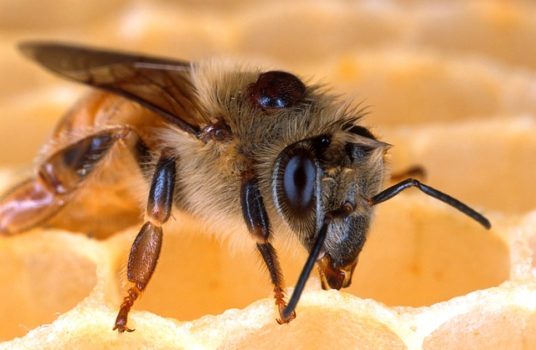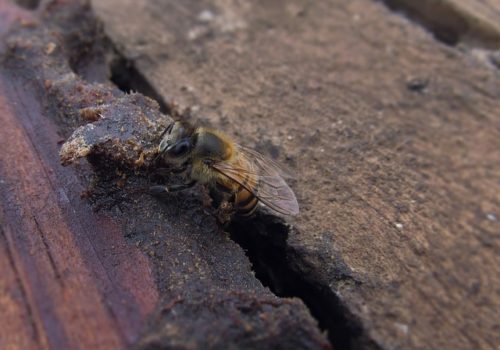Bee propolis is a new/old weapon in the fight against Varroa and Tracheal Mites! The antibiotic and antimicrobial properties of bee propolis are showing that it is a major benefit to a bee hive. This could be a game changer in the fight against colony collapse disorder.
All beekeepers have had issues with Varroa and Tracheal mites and the viruses and bacteria they infest a hive with. These pericytes are responsible for the death of honey bee colonies worldwide. They are also considered a big part of colony collapse disorder.
What can I use to fight viral, bacterial, and mite infections?
I wrote an article about the benefits of mushrooms in the fight against the infections that varroa and tracheal mites bring to a bee and a beehive. There are exciting new advances in the research. A link to that article is here.
Another thing that is being done to fight the collapse of honey bee colonies is new bee breeds. I have written article about one of these new bee breeds that is showing some great promise, the Saskatraz bee. I have some colonies of Saskatraz bees and have had great results so far.
Another incredible tool in the natural arsenal against mites and the viruses and bacteria they spread is bee propolis. Bee propolis is a natural product that is already produced in the hive by the bees themselves.
Propolis has been thought of as a problem to deal with in the hive. I remember speaking to a few beekeepers and having them tell me to scrape as much of the propolis out as you can. They instructed me that you need to leave more room for honey and have a neat and tidy hive without all the pesky sticky propolis that is only good to seal off cracks and holes.
It’s looking like the opposite is true for the health of the bee colony. Extensive research is proving that bee propolis is a major tool in the fight against the infections of bacteria, viruses, varroa, and tracheal mites.
The research is ongoing with great results from the University of Minnesota. Dr. Marla Spivak Leads the Spivak Honey Bee Lab at the University of Minnesota. She has a great team doing ongoing research on honey bees and has been making some great progress. The link to the Bee Lab is here.

What in the world is bee propolis?
Bee propolis is a natural occurring substance in the beehive. It’s the sticky stuff in the corners and cracks of the hive. Propolis is made by bees when they gather resins from trees, mix it with bees wax and bee saliva. It stays tacky and malleable until the temperature gets cold where it becomes stiff and brittle.
With the resins in the propolis comes some strong flavonoids and aromatic acids according to the excellent research from the University of Minnesota. These substances are toxic to many organisms. The propolis becomes a strong antibiotic and antimicrobial glue.
For a natural bee colony in a tree or cavern they will cover the entire inner surface and entrance of the hive with propolis. It creates a safe antibacterial surface surrounding the hive.
In commercial hives the bees use the propolis to seal cracks. Sometimes the bees will seal part of the entrances of the hive with propolis. This is thought to keep intruders and robbers out. But due to the smooth surface of the lumber, the bees don’t spread much propolis inside the hive like a natural hive.
What is Propolis historically thought of?
Many beekeepers think propolis is used to seal cracks in a hive body and a method of waterproofing the hive. This doesn’t seem to be the case. According to the research from the Spivak bee lab. Many hives have open bottoms and are not sealed at all and thrive.
There are some people trying to find health benefits for humans in propolis. There are theories, but not much definitive proof of the health benefits for humans. Many health food stores have bee propolis available.
The benefits that many claim bee propolis to have is:
- Cancer fighter
- Treats Candida Symptoms
- Stops Herpes Reproduction
- Stops and Prevents Colds
- Fights Parasites
- Improves Fertility for Women with Endometriosis
What research is showing Propolis does.
A natural occurring hive in a tree or cavern, bees will spread a lot of propolis around all over the interior and entrance of the hive. The larva in these natural hives are healthy with less disease. The research is showing that propolis is an effective prevention of infection in a bee colony.
A commercial manufactured hive has smooth sides and the bees don’t spread propolis all over. The bees only put propolis in the cracks so there is far less propolis around the bees themselves. With less propolis, this leaves the bees less protected from infection.
According to the research done at the University of Minnesota, bee propolis is some powerful stuff. A natural occurring hive will have the propolis all over the place creating a sanitary environment and a barrier for intruders. Both benefits are a powerful tool for the health of a bee colony.
Techniques for beekeepers to use propolis.
So, most beekeepers don’t have a ton of natural occurring bee colonies at their disposal. Most of us are using commercially-made or home-made equipment for our hives. Most of our hives have smooth lumber and the bees don’t spread much propolis in the interior of the hive. We see some at the top or in the cracks here and there. Sometimes thy will reduce an entrance with propolis, but that’s a far cry less than a natural hive.
There are some strategies you can use to help encourage your bees to create more propolis and spread it throughout the interior of the hive.
- You can rough up the interior of your hive bodies. Some beekeepers and using a wire brush or rough sand paper to rough up the interior of the hive. The result is that the bees will try to cover the rough spots with propolis.
- Many beekeepers are manufacturing their beehives with unfinished or rough lumber. The rough unsanded or unplaned lumber is pretty rough. This really encourages propolis placement in the hive.
- Another method is to put plastic film with holes inside the hive. The holes in the plastic promotes the bees to put propolis in the holes of the surface of the plastic.
- A non-recommended procedure of thinning some propolis and painting the inside of the hive body. This does not have the same result of the bees creating their own propolis and distributing it themselves.
- Trying to feed propolis to a bee colony. This is not recommended and does not produce the same result as the bees creating their own propolis.
A great video produced by the University of Minnesota illustrated this whole concept well:
Summary
What I have found is that bee propolis is very beneficial to a bee colony. The propolis itself has antibacterial and antimicrobial properties. These properties aid in the health of the new bee larva. This results in a healthier hive than those hives without much propolis.
Bee propolis occurs naturally in abundance in natural hives found in trees or natural crevasses. Bee propolis is not found in abundance in smooth commercially made beehives.
You can encourage bee propolis production in your own beehives is by making the hives with unfinished rough lumber. You can also rough up the inside of your hives with sandpaper or a wire brush. Another method is to stick some plastic film with holes on the interior walls of your hive. The bees want to fill the holes or cover the rough spots with propolis.
This is an excellent technique to use in your beehives. It is a natural way to combat the negative effects of unhealthy microbes, viruses, and bacteria. You may lose a small amount of honey production, but the benefits of a healthy hive will outweigh any time and nectar spent of the production of propolis.

